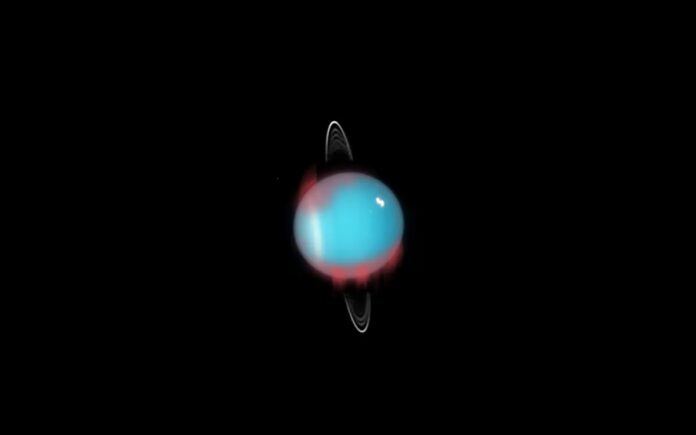Uranus is the cold outer planet. Its magnetic field is misaligned with the axes in which it spins. While scientists have yet to find an explanation for this, clues may lie in Uranus’s aurora.
Powerfully charged particles sent downward and strike a planet’s atmosphere through its magnetic field lines generate aurorae. On planets like Uranus, whose atmosphere primarily comprises hydrogen and helium, the aurora will radiate light in wavelengths such as the infrared (IR) outside the visible spectrum.
Astronomers at the University of Leicester used infrared auroral measurements by analyzing specific wavelengths of light emitted from the planet using the Keck II telescope. For the first time, they confirmed the presence of an infrared aurora on the Uranus.
The finding might answer questions about the origins of the solar system’s planets’ magnetic fields and possibly the possibility of life on other worlds.
From the measurements, scientists analyzed the light (emission lines) from these planets, similar to a barcode. The temperature of the charged particle, known as H3+, and the density of this layer of the atmosphere affect the brightness of the lines it emits in the infrared spectrum. As a result, the lines function as a planet’s thermometer.
With slight temperature variations, their observations showed considerable increases in H3+ density in Uranus’s atmosphere, which is compatible with ionization brought on by an infrared aurora. This aids in our comprehension of the magnetic fields of the outer planets in our solar system and could be helpful in locating other planets conducive to life support.
Lead author Emma Thomas, a Ph.D. student at the University of Leicester School of Physics and Astronomy, said: “The temperature of all the gas giant planets, including Uranus, are hundreds of degrees Kelvin/Celsius above what models predict if only warmed by the sun, leaving us with the big question of how these planets are so much hotter than expected? One theory suggests the energetic aurora is the cause of this, which generates and pushes heat from the aurora down towards the magnetic equator.”
“Most exoplanets discovered so far fall in the sub-Neptune category, and hence are physically similar to Neptune and Uranus in size. This may also mean similar magnetic and atmospheric characteristics. By analyzing Uranus’s aurora, which directly connects to the planet’s magnetic field and atmosphere, we can make predictions about these worlds’ atmospheres and magnetic fields and hence their suitability for life.”
“This paper is the culmination of 30 years of auroral study at Uranus, which has finally revealed the infrared aurora and begun a new age of aurora investigations at the planet. Our results will broaden our knowledge of ice giant auroras and strengthen our understanding of planetary magnetic fields in our solar system, at exoplanets, and even our planet.”
“We don’t have many studies on this phenomenon and hence do not know what effects this will have on systems that rely on Earth’s magnetic field, such as satellites, communications, and navigation. However, this process occurs every day at Uranus due to the unique misalignment of the rotational and magnetic axes. Continued study of Uranus’s aurora will provide data on what we can expect when Earth exhibits a future pole reversal and what that will mean for its magnetic field.”
Journal Reference:
- Thomas, E.M., Melin, H., Stallard, T.S. et al. Detection of the infrared aurora at Uranus with Keck-NIRSPEC. Nat Astron (2023). DOI: 10.1038/s41550-023-02096-5
